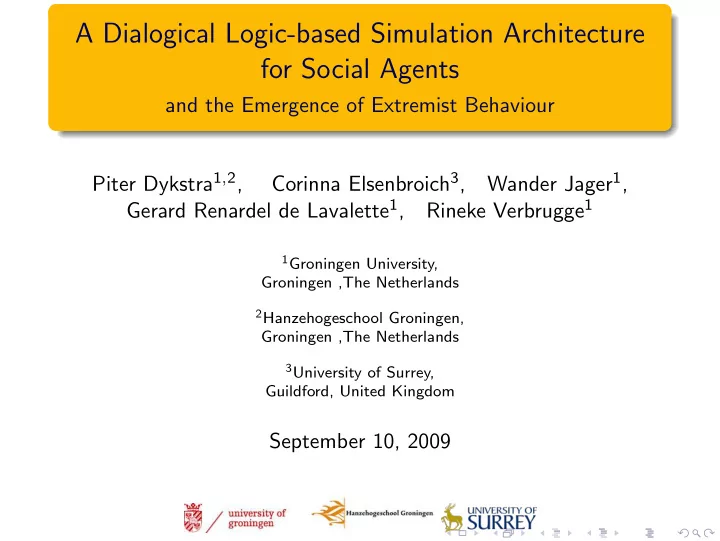

A Dialogical Logic-based Simulation Architecture for Social Agents and the Emergence of Extremist Behaviour Piter Dykstra 1 , 2 , Corinna Elsenbroich 3 , Wander Jager 1 , Gerard Renardel de Lavalette 1 , Rineke Verbrugge 1 1 Groningen University, Groningen ,The Netherlands 2 Hanzehogeschool Groningen, Groningen ,The Netherlands 3 University of Surrey, Guildford, United Kingdom September 10, 2009
Introduction Groups & Extreme Opinions Argumentation Concluding Remarks 1 Introduction 2 Groups & Extreme Opinions The ”Henhouse”-model The Demo 3 Argumentation Dialogical Logic Model with Dialogues 4 Concluding Remarks Piter Dykstra et al. A Dialogical Logic-based Simulation Architecture
Introduction Groups & Extreme Opinions Argumentation Concluding Remarks Central Question What causes the emergence of extreme opinions? Goal Agent-based Simulation with Reasoning Agents Piter Dykstra et al. A Dialogical Logic-based Simulation Architecture
Introduction Groups & Extreme Opinions Argumentation Concluding Remarks Central Question What causes the emergence of extreme opinions? Goal Agent-based Simulation with Reasoning Agents Piter Dykstra et al. A Dialogical Logic-based Simulation Architecture
Introduction Groups & Extreme Opinions Argumentation Concluding Remarks The ”Henhouse”-model Actions Announcements Loudness Evidence Importance Adopt opinion from other agents (assimilation) Move elsewhere (segregation) Piter Dykstra et al. A Dialogical Logic-based Simulation Architecture
Introduction Groups & Extreme Opinions Argumentation Concluding Remarks The ”Henhouse”-model The Topic Space Simulation of Common Knowledge Accumulation of evidence and importance Forgetting Formation of groups of agents Piter Dykstra et al. A Dialogical Logic-based Simulation Architecture
Introduction Groups & Extreme Opinions Argumentation Concluding Remarks The ”Henhouse”-model The Topic Space Simulation of Common Knowledge Accumulation of evidence and importance Forgetting Formation of groups of agents Reputation Status is determined by similarity with environment. Goal: Maximize RS Piter Dykstra et al. A Dialogical Logic-based Simulation Architecture
Introduction Groups & Extreme Opinions Argumentation Concluding Remarks The Demo RationalAgent program in an initial state (A) (B) (C) Agents Evidence Importance Piter Dykstra et al. A Dialogical Logic-based Simulation Architecture
Introduction Groups & Extreme Opinions Argumentation Concluding Remarks The Demo RationalAgent with social knowledge (A) (B) (C) Agents Evidence Importance Piter Dykstra et al. A Dialogical Logic-based Simulation Architecture
Introduction Groups & Extreme Opinions Argumentation Concluding Remarks The Demo Results I Emergence of extreme opinions Decrease of importance of opinions (and communication) Formation of (different kinds of) groups. No reasoning or argumentation involved Piter Dykstra et al. A Dialogical Logic-based Simulation Architecture
Introduction Groups & Extreme Opinions Argumentation Concluding Remarks Dialogical Logic Dialogues in Rational Agents Proponent - Opponent Initial Announcement Attacks Defences Alternating Moves Winning Pay - Reward Piter Dykstra et al. A Dialogical Logic-based Simulation Architecture
Introduction Groups & Extreme Opinions Argumentation Concluding Remarks Dialogical Logic Dialogues Proponent - Opponent Initial Announcement Attacks Defences Alternating Moves Winning Pay - Reward Reputation Status is determined by winning and losing dialogues. Piter Dykstra et al. A Dialogical Logic-based Simulation Architecture
Introduction Groups & Extreme Opinions Argumentation Concluding Remarks Dialogical Logic Example of a Dialogue A: If we do not have enough funding and refugees create additional costs, then they should leave this country. B: Why do you say that? A: Well, prove me wrong! If you can I give you 1 RS but if I am right you have to pay me 0.50 RS . B: Ok, deal. I really disagree with your conclusion. . . . A: Do you agree then that we do not have enough funding and that refugees create additional costs. B: Yes of course, that can hardly be denied. A: Right. . . – people, do you believe refugees should leave this country? Piter Dykstra et al. A Dialogical Logic-based Simulation Architecture
Introduction Groups & Extreme Opinions Argumentation Concluding Remarks Dialogical Logic 2-D Logic Evidence: P ( ϕ ) E ( ϕ ) = P ( ϕ )+ R ( ϕ ) Importance: I ( ϕ ) = P ( ϕ )+ R ( ϕ ) 2 Piter Dykstra et al. A Dialogical Logic-based Simulation Architecture
Introduction Groups & Extreme Opinions Argumentation Concluding Remarks Dialogical Logic 2-D Logic Evidence: P ( ϕ ) E ( ϕ ) = P ( ϕ )+ R ( ϕ ) Importance: I ( ϕ ) = P ( ϕ )+ R ( ϕ ) 2 Piter Dykstra et al. A Dialogical Logic-based Simulation Architecture
Introduction Groups & Extreme Opinions Argumentation Concluding Remarks Model with Dialogues RationalAgent with dialogues Piter Dykstra et al. A Dialogical Logic-based Simulation Architecture
Introduction Groups & Extreme Opinions Argumentation Concluding Remarks Model with Dialogues Results II No extremization of opinions No decrease of importance One agent wins all the RS-points and determines the ruling opinion Communication stops Piter Dykstra et al. A Dialogical Logic-based Simulation Architecture
Introduction Groups & Extreme Opinions Argumentation Concluding Remarks Logic in Rational Agents Epistemic Logic for Higher Order Reasoning Pitfall: the perfect reasoner Dialogical Non-Monotonic Multi-Valued Paraconsistent Piter Dykstra et al. A Dialogical Logic-based Simulation Architecture
Introduction Groups & Extreme Opinions Argumentation Concluding Remarks The Competition Social Network Analysis (Sun and Breiger) Belief-Desire-Intention (Flache & Macy) Game Theory (van Benthem) Constructuralism (Carley) Piter Dykstra et al. A Dialogical Logic-based Simulation Architecture
Recommend
More recommend